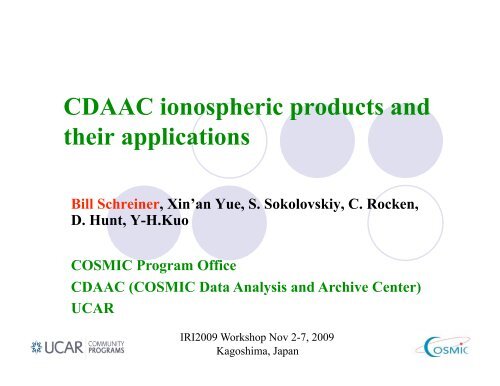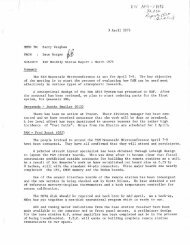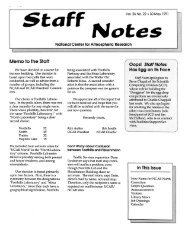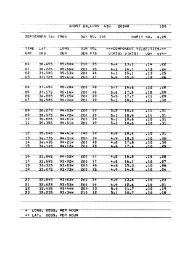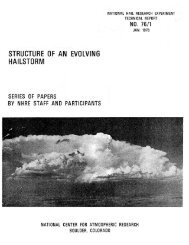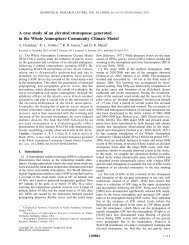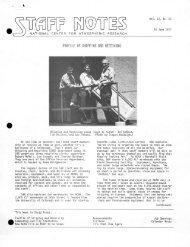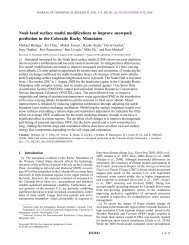CDAAC ionospheric products and their applications
CDAAC ionospheric products and their applications
CDAAC ionospheric products and their applications
Create successful ePaper yourself
Turn your PDF publications into a flip-book with our unique Google optimized e-Paper software.
<strong>CDAAC</strong> <strong>ionospheric</strong> <strong>products</strong> <strong>and</strong><br />
<strong>their</strong> <strong>applications</strong><br />
Bill Schreiner, Xin’an Yue, S. Sokolovskiy, C. Rocken,<br />
D. Hunt, Y-H.Kuo<br />
COSMIC Program Office<br />
<strong>CDAAC</strong> (COSMIC Data Analysis <strong>and</strong> Archive Center)<br />
UCAR<br />
IRI2009 Workshop Nov 2-7, 2009<br />
Kagoshima, Japan
Outline<br />
� COSMIC <strong>and</strong> <strong>CDAAC</strong> Overview<br />
� Scientific research using <strong>CDAAC</strong><br />
ionosphere <strong>products</strong><br />
� Future Plans<br />
2
COSMIC at a Glance<br />
� Constellation Observing System for Meteorology<br />
Ionosphere <strong>and</strong> Climate<br />
� Joint US, Taiwan Mission (FORMOSAT-3)<br />
� 6 Satellites launched in Apr 2006<br />
� Orbits: alt=800km, Inc=72deg, ecc=0, ∆Ω=30deg<br />
� GPS Radio Occultation Receiver:<br />
o Refractivity<br />
o Pressure, Temperature, Humidity<br />
o Absolute TEC<br />
o Electron Density Profiles (EDP)<br />
o Ionospheric Scintillation (S4 amplitude)<br />
• Tiny Ionospheric Photometer (TIP) – Radiances<br />
• Tri-B<strong>and</strong> Beacon Transmitter<br />
� Demonstrate quasi-operational GPS limb sounding with<br />
global coverage in near-real time<br />
� Climate Monitoring<br />
� Useful for many <strong>ionospheric</strong> studies<br />
3
<strong>CDAAC</strong> File types in RED<br />
LEO data Level 0--level 1<br />
Fiducial<br />
data<br />
POD (Orbits<br />
<strong>and</strong> clocks)<br />
podTec (TEC)<br />
scnLv1 (S4)<br />
tipLv1 (Radiance)<br />
<strong>CDAAC</strong> Processing Flow<br />
Atmospheric processing<br />
Excess Phase<br />
Ionospheric processing<br />
Excess Phase<br />
Processing<br />
atmPhs atmPrf<br />
Full Spectrum<br />
Abel Inversion<br />
(S4)<br />
Real time Task Scheduling Software<br />
ionPhs<br />
(L1,L2<br />
amp/phase)<br />
Abel Inversion<br />
ionPrf<br />
(EDPs)<br />
wetPrf<br />
1-D Var<br />
Moisture<br />
Correction<br />
Profiles<br />
bfrPrf<br />
Combination<br />
with other data<br />
4
<strong>CDAAC</strong> processing data for these<br />
Radio Occultation missions<br />
COSMIC CHAMP GPSMET<br />
GRACE SAC-C TerraSAR-X<br />
Metop/GRAS,<br />
others available soon<br />
5
� By using these <strong>CDAAC</strong> observations, many scientific<br />
works have been done, including:<br />
1. Data comparison <strong>and</strong> validation<br />
2. Model validation<br />
3. Ionosphere climatology/Ionosphere weather/space weather<br />
4. Topside ionosphere/plasmasphere<br />
5. Ionosphere scintillation/Es<br />
6. Ionosphere-atmosphere coupling<br />
7. Data assimilation <strong>and</strong> other <strong>applications</strong><br />
8. ……………………….<br />
6
Electron Density Profiles<br />
• Electron Density Profiles, EDPs (level2:ionPrf)<br />
- Number ~2.7M: COSMIC (4/06-9/09: 2.4M), CHAMP (5/01-10/08: 300,000)<br />
- Abel Inversion assumes spherical symmetry: Significant inversion errors below F2 layer<br />
- NOTE: Fixed COSMIC level0->level1a s/w bug, corrected noisy profiles after 2008.001<br />
- Quality Control still needs<br />
improvement<br />
Lei et al.,<br />
2006JA012240<br />
7<br />
Unit: 1×10 5 /
Tsai et al. [2009RS004154] constructed a new<br />
EDPs model (TWIM) using COSMIC<br />
8
Profile modeling: >2.5 million profiles<br />
Eg. Estimation of IRI profile parameters from COSMIC EDPs<br />
Liu et al., 2008JA013490<br />
9
Ionosphere High Transition Height (in progress)<br />
� Method: Assume the diffusion equilibrium of O+ in the topside. Obtain the scale height of<br />
O+ from the profile <strong>and</strong> then calculate the profile of O+. [Kutiev et al., 2004]<br />
� HTH comparison between COSMIC <strong>and</strong> C/NOFS observations for the same latitude region<br />
<strong>and</strong> time period: Lat [-13 13], June-August, 2008<br />
COSMIC<br />
C/NOFS<br />
The maximum of COSMIC HTH during daytime is about 100km lower than C/NOFS (this may<br />
10<br />
be related with the error of our method). Note: C/NOFS has a much smaller sample
• Absolute TEC (level1b:podTec)<br />
Absolute TEC Data<br />
- Number > 3.2M: COSMIC (4/06-9/09: ~3M),<br />
CHAMP (5/01-10/08: 200,000)<br />
- NOTE: Fixed COSMIC level1a->level1b s/w<br />
bug <strong>and</strong> reprocessed 2008.001 onwards<br />
resulting in 700,000 more arcs<br />
- Absolute accuracy ~ 1-3 TECU,<br />
- Relative accuracy ~ 0.0024 TECU at 1-Hz<br />
sampling (COSMIC: 2009.001-004)<br />
- Quality Control is good<br />
COSMIC trans<strong>ionospheric</strong><br />
radio links<br />
for a 100-min period,<br />
June 29, 2007<br />
11
Ionosphere top-side response to the 15 December 2006<br />
storm by COSMIC podTec<br />
Pedatella et al., 2009<br />
12
Ionosphere response to sudden stratosphere warming<br />
(~Jan 20, 2009) seen in topside ionosphere<br />
• Topside TEC (> 800 km) in the<br />
topside increase in the morning<br />
• TEC decreases in the afternoon<br />
• This results agrees with study of<br />
ground-based GPS [Goncharenko et<br />
al. 2009,CEDAR meeting]<br />
• NEW: Topside TEC is good<br />
evidence that the SSW affects the<br />
ionosphere by changing the tides <strong>and</strong><br />
then the electric field in ionosphere<br />
(only EXB can reach high altitude)<br />
Deviation (TECU)<br />
vTEC(SSW month) - vTEC(preSSW month)<br />
13
• Scintillation S4 (level2:atmPrf)<br />
Scintillation Data<br />
- Computed from 50-Hz Occultation L1 SNR observations (60-80 km alt)<br />
- Number: COSMIC (4/06-3/09: ~2M), CHAMP (5/01-10/08: 393,000), GRACE<br />
(11/06-3/09: 90,000), GPSMET (5/95-2/97: ~5,000: ~4,000 AS)<br />
• COSMIC Scintillation S4 (level1b:scnLv1)<br />
- Downloaded 1-Hz values from all line of sites (based on 50-Hz L1 SNR)<br />
- Number: > 4.5M LEO-GPS arcs<br />
Scintillation from level1b:scnLv1 (9-sec averages)<br />
E layer F layer<br />
14
Tiny Ionospheric Photometer<br />
• COSMIC Calibrated TIP radiances (level1b:tipLv1)<br />
- TIP payload off for FM2/3<br />
- > 1400 hours of data<br />
COSMIC TIP: 2006-2009, ~1400 hours<br />
Auroral Oval seen both by TIP (left)<br />
<strong>and</strong> low altitude EDPs (right)<br />
Tsai et al., 2009<br />
15
� Future plan for the <strong>CDAAC</strong>:<br />
1. Add more satellite missions<br />
2. Improve the data retrieval method <strong>and</strong> data quality control<br />
3. Continue to provide free data <strong>and</strong> more convenient way to get<br />
the data<br />
4. Just had 4 th FormoSat-3/COSMIC Data Users WS, see website<br />
16
COSMIC Data Access<br />
COSMIC Web site http://www.cosmic.ucar.edu<br />
• Select the 'Sign Up ' link under<br />
COSMIC<br />
• Accept data use agreement<br />
• E-mail will be sent within 2-3<br />
business days to indicate<br />
access has been granted<br />
• Raw Data from multiple missions<br />
• TEC, EDPs, S4, TIP in NetCDF<br />
format<br />
• On-line SQL database, analysis tools<br />
<strong>and</strong> data download<br />
• Unidata LDM access<br />
http://www.unidata.ucar.edu/Projects/<br />
COSMIC/data_opportunity.html<br />
17
• NSF<br />
Acknowledgments<br />
• Taiwan’s NSPO<br />
• NASA/JPL, NOAA, USAF, ONR, NRL<br />
• Broad Reach Engineering<br />
18


